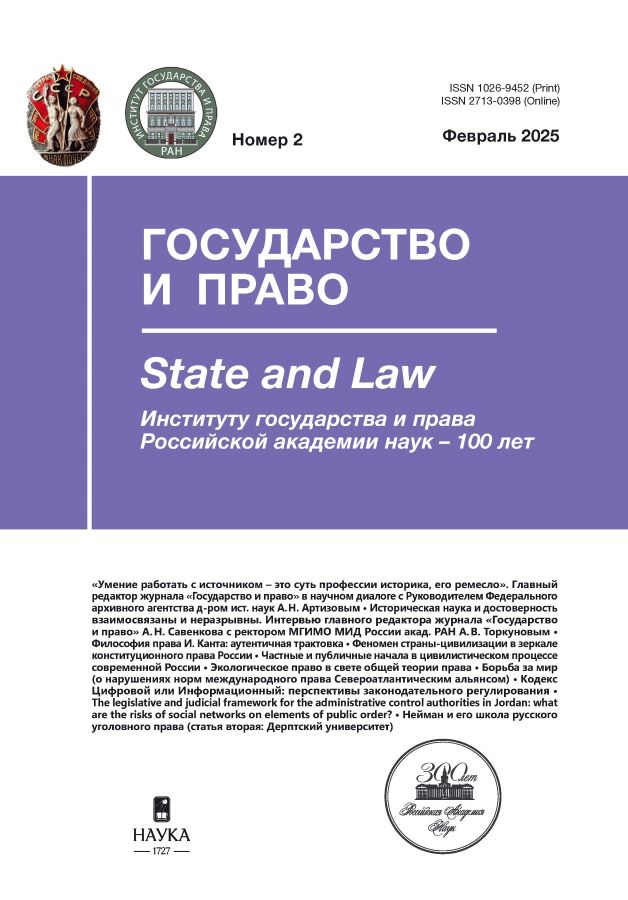The legal history of the struggle for civil rights: the role of social movements in achieving racial equality in the United States
- 作者: Latypova N.S.1
-
隶属关系:
- Ufa University of Science and Technology
- 期: 编号 2 (2025)
- 页面: 172-178
- 栏目: Scientific reports
- URL: https://rjmseer.com/1026-9452/article/view/682853
- DOI: https://doi.org/10.31857/S1026945225020177
- ID: 682853
如何引用文章
详细
The article presents a retrospective analysis of the development of civil rights in the United States. Since the signing of the Declaration of Independence, the United States of America has gone from a slave-owning state to a State with not only declared, but also actually embodied ideas of freedom and equality of all citizens. Social movements have played a major role in the process of asserting civil rights, allowing hundreds of thousands of African Americans, women, Latinos, and ordinary workers to be heard. However, despite the rights and freedoms enshrined in the U. S. Constitution, many social groups still face discrimination based on race, gender, and social status, and the struggle for equality causes acute social conflicts and becomes an urgent agenda in the American states of the 21st century. The purpose of the work is to establish the role of social movements in the development of legislation on civil rights, to trace the historical relationship and mutual correlation of the formation and development of social movements and the modernization of social legislation, the legal consolidation of labor, political and economic rights. The methodology was based on the comparative historical method, which made it possible to draw up an objective picture of legal and social changes at various historical stages. The concrete legal method formed the basis for evaluating legally significant decisions taken in the field of securing civil rights, as well as the historical and genetic method used to determine the points of origin and development not only of civil rights legislation, but also of the legal culture associated with them. The result of the study was the conclusion that there is a direct correlation between the activities of active social groups and movements and the adoption of normative acts that enshrine the rights of individual social groups. The main ways to influence public opinion and the political will of existing public authorities that oppose the expansion of civil rights have become mass protests and public appearances in the media, challenging government policy in the courts, and creating judicial precedents. Having traced the historical path of the civil rights movements, the authors come to the conclusion about their dominant role in the process of evolution of social legislation and accelerating the transformation of public opinion.
全文:
作者简介
Natalia Latypova
Ufa University of Science and Technology
编辑信件的主要联系方式.
Email: marchrose@yandex.ru
ORCID iD: 0000-0002-4583-3765
PhD in Law, Deputy Director for Science, Associate Professor of the Department of Theory of State and Law, Institute of Law
俄罗斯联邦, 131 Dostoevsky str., 450005 Republic of Bashkortostan, Ufa参考
- Gevorkyan G. N. The influence of mass movements in the United States on the adoption of the civil rights Act of 1964 // MNIZH. 2016. No. 8–1 (50) (in Russ.).
- Gnedash A. A. The fourth wave of feminism: political discourse and opinion leaders on the social network Twitter // Herald of RUDN University. Ser.: Political Science. 2022. No. 1 (in Russ.).
- Allen A. L. Discrimination, Jobs, and Politics. Faculty Scholarship at Penn Law. 1986. Vol. 807. URL: https://scholarship.law.upenn.edu/faculty_scholarship/807 (accessed: 26.01.2024).
- Carson C. et. al. eds. The Papers of Martin Luther King, Jr.: Birth of a New Age, December 1955–December 1956. University of California Press, 1997.
- Davis S. N., Winslow S., Maume D. J. Gender in the Twenty-First Century: The Stalled Revolution and the Road to Equality. University of Carolina Press, 2017.
- Finkelman P. and Smith J. C. Not Only the Judges’ Robes Were Black: African-American Lawyers as Social Engineers // Stanford Law Review. 1994. Vol. 47. No. 1. Pp. 161–209.
- Gordon G., Kelly M., Wallace M. Occupational gender segregation, globalization and gender earnings inequality in U.S. metropolitan areas // Gender and Society. 2012. Vol. 26. No. 5. Pp. 718–747.
- Mack K. W. Representing the Race: The Creation of the Civil Rights Lawyer. Harvard Univ., 2012.
- Marshall T. Argument Before the U. S. Supreme Court in Brown v. Board of Education. URL: https://www.blackpast.org/african-american-history/1953-thurgood-marshall-argument-u-s-supreme-court-brown-v-board-education/ (accessed: 25.02.2024).
- McGowan V.J., Bambra C. COVID-19 mortality and deprivation: pandemic, syndemic, and endemic health inequalities // The Lancet Public Health. 2022. Vol. 7. No. 11. Pp. e966–e975..
- Narnolia N., Kumar N. Being Black in 21st-Century America: Struggle, Challenges and Possibilities // Journal of Social Inclusion Studies. 2001. Vol. 7. No. 2.
- Rubinowitz L. S. The Courage of Civil Rights Lawyers: Fred Gray and His Colleagues, 67 Case W. Rsrv. L. Rev. 1227 (2017). URL: https://scholarlycommons.law.case.edu/caselrev/vol67/iss4/17 (accessed: 20.02.2024).
- Schweninger L. Slave Women, County Courts, and the Law in the United States South: A Comparative Perspective // European Review of History issue titled Citizenship and the State in Classical Antiquity and the Modern Americas. 2009. Vol. 16. Pp. 383–399.
- Slatton B., Brailey C. Women and Inequality in the Century. Routledge, 2019.
- Williams R. F. “Black Power”, and the Roots of the African American Freedom Struggle // The Journal of American History. 1998. Vol. 85. No. 2. Pp. 540–570.
补充文件









